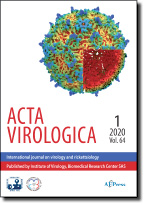Acta Virologica Vol.56, No.4, p.283-291, 2012
|
| Title: Comparative analysis of the envelope glycoproteins of foamy viruses |
| Author: YAN SUN, DI-DI WEN, QING-MEI LIU, XIAO-FANG YI, TING-TING WANG, LIN-LAN WEI, ZHI LI, WAN-HONG LIU, XIAO-HUA HE |
|
Abstract: One of the most fascinating findings in retrovirology is the construction of viral vectors based on foamy viruses (FVs) for gene therapy. The envelope glycoprotein (Env), one of the structural proteins of FV, is an important antigen in the immunoassays, as it is highly specific. To compare the characteristics of all 15 available FV Envs, the phylogenesis, hydrophobicity, modifications, and conserved motifs were analyzed based on the Env sequences. Meanwhile, the secondary structures of transmembrane (TM) domains of FV Envs were predicted. The results of phylogenetic analyses based on Envs indicated that the foamy viruses from different hosts could form three groups. The hydrophobicity analysis revealed that FV Envs had two prominent hydrophobic regions, which was similar to other retroviruses. Though the glycosylation, ubiquitination, and the secondary structures of TM domains of FV Envs were in line with other retroviruses, the roles were distinctly different. Interestingly, the analyses of conserved motifs suggested that FV Envs possessed several specific functional motifs.
|
|
| Keywords: foamy virus; envelope glycoprotein; sequence analysis; phylogenetic analysis |
|
|
|
| Year: 2012, Volume: 56, Issue: 4 |
Page From: 283, Page To: 291 |
doi:10.4149/av_2012_04_283
|
Price:
18.00 €
|
|
|
|
|
|
|
|

